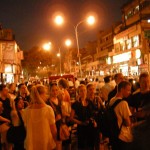Walking tour of old Delhi, 14 March 2010
A group of students from Denmark on their first trip to India joined us for a heritage walk in old Delhi on Sunday evening. The old city of Delhi is the capital built by the Mughal emperor Shahjahan, who named the new capital after himself, Shahjahanabad. The Red Fort was his palace-fort complex and Jama Masjid the congregation mosque of the city.
We wandered through the narrow lanes of old Delhi: looking at the haveli facades in Katra Khushal Rai, the Digamber Jain Naya Mandir, Naughara, Parathewali Gali. The havelis and Jain temples in the city have a typical late-Mughal aesthetic style: the arches, the life-like representation of flowers, etc, patronised by Shahjahan and used extensively after him. Naughara is a group of havelis (mansions) which still retain much of their traditional appearance.
Next on the route was the main street of Chandni Chowk, which used to have a stream flowing down its centre with pools at chowks (square) which reflected moonlight. Hence, the name, moonlight square! The Sunheri Masjid (golden mosque) and gurudwara Sisganj stand adjacent to each other. The mosque has domes gilded in copper which would shine brightly. It is said that when Nadir Shah raided Delhi, he watched the massacre of its citizens from the terrace of this very mosque. The gurudwara building is a modern one, but the site marks the martyrdom of Guru Teg Bahadur by the Mughal Emperor Aurangzeb in 1675. We ended the walk at Digamber Jain Lal Mandir, the oldest Jain temple in the area. It boasts of the only bird hospital in Delhi.
(posted by Rajesh Ranjan & Kanika Singh, team members, Delhi Heritage Walks)












